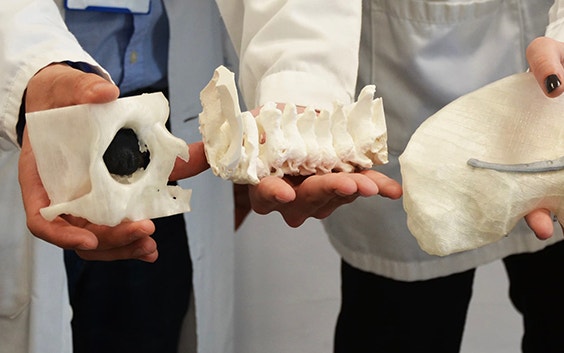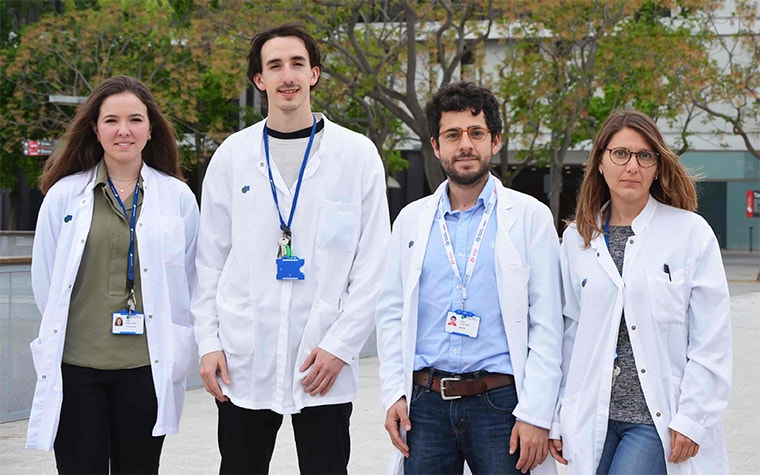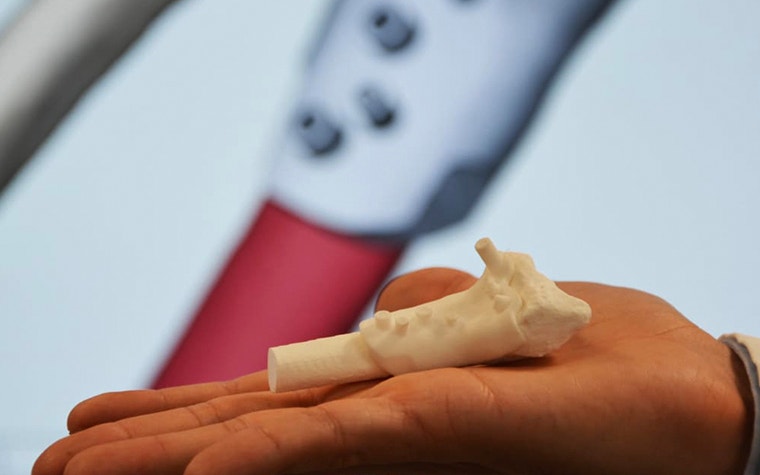
INTERVIEW
Hospital De Sabadell’s 3D Lab Is Transforming Surgical Care for Optimal Outcomes
Located in Sabadell near Barcelona, Spain, Hospital de Sabadell (also known as Hospital Parc Tauli) is a leading teaching hospital and respected research and development institute. In addition to providing patient care through a wide variety of healthcare services and specialist units, the hospital pioneers new ways of thinking, validating, and innovating — currently boasting more than 800 live research projects.
In 2015 the hospital launched a resource that has since become an integral part of both its innovation mission and commitment to healthcare excellence: the 3D Laboratory. They initially brought in point-of-care 3D printing to focus on harnessing the benefits of 3D planning and printing for applications in orthopaedic surgery. However, soon they expanded to span almost all departments — already generating clear benefits in terms of surgical and operational efficiency.
We spoke to Dr. Ferran Fillat, Orthopaedic Surgeon and 3D Lab Coordinator at Hospital de Sabadell, to find out how point-of-care 3D printing has become so crucial to his colleagues and why he thinks their partnership with Materialise is so important.
What was the initial driver to set up point-of-care 3D printing?
Proven success. We first started looking at the benefits of 3D printing in 2014, initially printing anatomical models — through an external service provider — to support planning for specific orthopaedic surgeries. It worked very well, and we could see the concept had significant potential for a much wider range of applications. So, we made the case and applied for a grant from the Society of Orthopaedic Surgery in Catalonia and bought our first 3D printer. Our 3D Lab was born.


With that printer came training. We also experimented with free software tools at first and started developing our segmentation and design skills — applying what we were learning, initially, to preoperative planning for proximal humeral fractures. It wasn’t long before we realized how useful this could be and started introducing different applications.
What are the lab’s capabilities today?
In our first year, we supported 15 cases. The year after, we doubled that. Last year we started working with Materialise’s Mimics Core and inPrint software solutions, and we’re now up to over 100 cases. Having the right software in place has really made a big difference to our capabilities and growth.
We are able to prepare preoperative surgical plans and create all our own designs with confidence, safe in the knowledge that the software we use is CE marked and suitable for medical use. We print anatomical models on site and send our files for personalized surgical guides (that require a specific medical device manufacturing license) off to our external printing partner.
Do you focus primarily on orthopaedic cases?
I am an orthopaedic surgeon. I think that, and our initial focus on orthopaedic cases when the Lab started out, means we have developed a strong specialty in this area. We have certainly become experts in producing surgical guides for scaphoid, elbow, distal radius, shoulder, and knee surgeries, through to spinal procedures and osteotomies.
Over the last year, however, we have really opened up and now work with many departments across the hospital. For instance, we’ve worked on cases and projects from vascular surgery, pediatrics, hepatic surgery, maxillofacial surgery, and cardiology. The whole hospital knows about what we do in the 3D Lab and they want to work with us.
What’s been key to the lab expanding its range of applications in this way?
When you first start thinking about in-hospital 3D printing, you automatically think that the actual printer is going to be the most important thing. And it is, to a degree. The machines we have on site now enable us to print guide prototypes and our own anatomical models, both of which are essential to what we do.
But it’s the software that’s been absolutely crucial, not just in terms of the 3D planning functionality and specific device design tools, but because it has helped us establish the right pathways. In that sense, it really is the critical foundation on which everything else is built. The right software enables us to fit 3D planning and printing into efficient workflows with surgeons, other departments, and of course, with external printing partners.
For any in-hospital 3D facility to succeed, surgeons need to understand the possibilities and processes, and most importantly, they must be able to work with biomechanical engineers easily, quickly, and collaboratively. It isn’t the printer that makes that possible; it’s the people and the software.


Is there a standard process for how cases or projects are initiated?
For orthopaedic surgical planning and guide applications, we are very case-focused. If a surgeon has a patient case they would like us to look at, they submit a formal application for us to review.
As we are in-house, we can access all the relevant medical imaging files etc. and, using Mimics, can very quickly turn scans and X-rays into a proposed plan and guide design. Through Materialise Mimics Viewer we can share this with the responsible surgeon for review and any modifications — with Mimics inPrint we may also print an anatomical model to assess fit of the prototype guide. Finally, we will send the approved files off to a certified manufacturer.
“Planning matches reality because that planning is optimized for the best results based on the patient’s specific anatomy.”
However, a lot of our projects also start as doctoral theses. For these, we work very closely with our research institute and ethical committee to look at viability and potential fundability, as in some cases we may apply for grants to proceed depending on the nature of the project.
What benefits have 3D software and printing solutions already delivered?
With preoperative plans and surgical guides, the biggest benefit is confidence. The up-front insights that our 3D solutions provide give surgeons and their teams the confidence that how they plan each procedure will reflect the experience in theater. Planning matches reality because that planning is optimized for the best results based on the patient’s specific anatomy. This is positive for us and for patients.
Being able to demonstrate that surgeries are being carried out exactly as intended is a major step forward.
“We are definitely saving time. In fact, 3D software and printing technology has enabled us to reduce surgery times by up to 50% for orthopaedic applications such as scaphoid surgery.”
We will, of course, need more time to assess long-term benefits to patients. For instance, we will need to accumulate around five years’ worth of follow-up data to look at an area like shoulder arthroplasty in terms of “with 3D planning” versus “without.” What we do know already, though, is that none of our surgeons now want to carry out this procedure without a guide. In this context, 3D solutions have already started changing our clinical practice completely.
Have you noticed any other differences, perhaps in terms of time or resource efficiency?
Yes, we are definitely saving time. In fact, 3D software and printing technology has enabled us to reduce surgery times by up to 50% for orthopaedic applications such as scaphoid surgery.
Having learned a lot about our method, we’re also now — particularly thanks to Materialise’s Mimics software — at a stage where we are optimizing our own processes in the 3D Lab, and that will eventually produce operational benefits for the hospital in terms of the number of cases we can work on. It used to take around one week to develop a scaphoid guide, but now we can create a clear design for surgeon approval/modification in less than ten minutes.
Materialise’s software, together with our accumulating experience, is enabling us to automate planning and guide development much better.
Why is automation so important, and how does the software help?
Building case volume is essential for optimizing the benefits I’ve already mentioned and for demonstrating the clinical and operational value of 3D solutions. We are a team of four, so making what we do efficient and scalable is key — optimization through automation is how that will happen. How it already is happening.
The customizable scripting module in Mimics is fundamental to this as it allows us to analyze more patient data, more quickly, and automate our workflows to cut out any time-consuming, repetitive steps and improve consistency. 3D preoperative planning is all about tailoring solutions to match an individual patient’s needs, but the best way to do this is to achieve consistency in the tailoring approach. This is so important for expanding our range of applications at a much faster pace.
As a result of the time saved, you can produce preoperative plans and device designs in dramatically less time with complete confidence. Less time means more capacity and the ability to work on more cases.
Finally, what’s your next goal for the 3D Lab?
Our ultimate aim is to get to a point where all patients who could benefit from preoperative 3D planning and surgical guides do benefit. What I was just saying about the importance of software-driven automation and scalability is integral to this. The second thing crucial to achieving our ambition is a focus on clinical and process quality control.
We are already working on getting our own license to print medical devices so that we can produce surgical guides on site. This isn’t about us wanting to sell medical devices. For us, it is simply about making sure we are doing things well. About knowing that the processes we are developing and implementing have the highest levels of quality control. With the Mimics Innovation Suite and inPrint, we have CE-marked software that’s suitable for medical use. We also have the right in-house expertise, so I’m confident we have the ideal set-up to pass the ISO certification needed to achieve this goal and demonstrate the quality of what we do.
With medical 3D printing, some things should be outsourced. However, we believe 3D surgical planning, — from design to print — is something that belongs entirely on site. The benefits on offer are magnified if they can be embedded into daily hospital life. With Materialise, we are taking the right steps to make this happens at Hospital de Sabadell.
L-101207-001
Share on:
You might also like
Never miss a story like this. Get curated content delivered straight to your inbox.
